 Historian Steven Palmer has helped to produce a book about Cuba’s first republic, 1902 to 1959.
Historian Steven Palmer has helped to produce a book about Cuba’s first republic, 1902 to 1959.
Although Cuba’s first republic, which lasted from 1902 to the 1930s, ended in the Batista dictatorship, it represents a crucial time in the nation’s development, says UWindsor historian Steven Palmer.
A symposium at the University of Windsor on the period, which brought together Canadian, Cuban, Spanish and American historians, spawned a book on the subject, edited by Dr. Palmer along with his colleagues José Antonio Piqueras and Amparo Sánchez Cobos of the Universitat Jaume I in Castellón, Spain.
 Duke University Press published State of Ambiguity: Civic Life and Culture in Cuba’s First Republic in April.
Duke University Press published State of Ambiguity: Civic Life and Culture in Cuba’s First Republic in April.
“Basically it was the birth of Cuban civil society and democratic politics,” says Palmer, Canada Research Chair in History of International Health. “Things went tragically wrong, but the authors reject the argument that just because it ends poorly means there’s nothing to talk about.”
Palmer says this period saw a lot of civic infrastructure built in Cuba, from public buildings to highways, the establishment of independent scientific institutions, and a flourishing literary world.
“There was a real expansion of literary and journalistic cultures. Lots and lots of newspapers, periodicals, journals as a manifestation of the richness of democratic life, of that time,” Palmer says.
His chapter in the book focuses on the country’s medical development. He says it is important to bring those aspects into mainstream discussion: “The history of medicine and health there was central to the political story and central to what was going on in Cuban life.”
The May 2010 symposium attracted scholars working on different aspects of Cuban history. Pooling their research into a comprehensive book specifically covering Cuba’s first republic seemed like a natural progression.
“This time period in Cuban history doesn’t get talked about much for a variety of reasons, but with Cubans today working toward greater democracy, it is important to recall this period of intense democratic creativity,” says Palmer.
